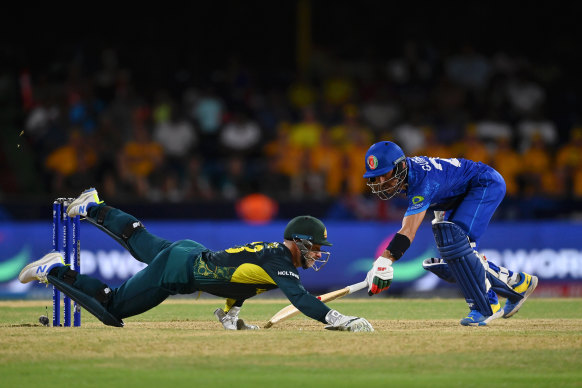Cricket
Afghanistan trigger a cricket earthquake, put Australia’s cup campaign on the ropes

Afghanistan have the advantage of playing Bangladesh on Tuesday morning after Australia face India on Monday night, therefore knowing exactly what they will need to achieve to progress at Australia’s expense. Marsh’s team must win and then hope to stay ahead of Afghanistan on run rate.
The decision to leave out Mitchell Starc for Ashton Agar, based on the likelihood of a turning track, will be debated given the left-arm paceman’s vaunted reputation. So too will the decision to chase after Marsh won the toss. Agar, though, bowled tidily, and it was in the field where the Australians fell down most visibly. Marsh estimated that Afghanistan were allowed to get 20 runs too many.
Glenn Maxwell threatened to win the game for Australia with the bat but was dismissed for 59 off 41 balls.Credit: Getty Images
“We don’t want to have too many off nights in the field, but I also believe at our best we’re an unbelievable fielding side,” Marsh said. “We certainly pride ourselves on our fielding, and can’t question the boys put in the work, it’s no different to any other skill set.
“Any time you make a decision like that, Starcy is unlucky in a sense, but we’ve said from the start of the tournament that we’ve got 15 guys here, and we’ll pick a team that we think will win us the game in the conditions, and everything pointed towards Ash tonight.”
The decidedly sketchy fielding display, reminiscent of the way Australia performed against Scotland in the final game of the pool phase, made the chase considerably more challenging than it might otherwise have been.

Matthew Wade misses a stumping chance.Credit: Getty Images
When Maxwell was finding the gaps and clearing the boundary, the early loss of three wickets did not appear to matter too much. But from the point of needing 43 from 33 balls with five wickets in hand and Maxwell well established, the Australians lost a catastrophic 5-21 to fall well short.
Apart from Maxwell, no other batter made more than 12 – with a quartet of vital wickets being taken by the change bowler Gulbadin Naib, the last of eight bowlers called upon by Rashid to defend a target of 149.
Adam Zampa and Marcus Stoinis had dropped difficult chances, but Travis Head, Agar and David Warner would all have expected to do more with the offerings that came their way. Matthew Wade, too, missed a stumping chance as Afghanistan notched a century opening stand.
No wickets fell until the 16th over when Stoinis nabbed Gurbaz (and gave the opener a theatrical wave goodbye), helping Zampa to chime in with a pair of customary breakthroughs – although the second was unusual for effectively being achieved with a bouncer.
Cummins achieved a feat only previously achieved by Wasim Akram by claiming a second hat-trick in successive matches, this time being very aware of the fact and celebrating accordingly. But it rather summed up the fielding display when Cummins was denied a fourth wicket in as many balls because Warner shelled a low catch.
Afghanistan, though, held all their catches, three of them brilliant. Australia’s 70 per cent catching efficiency is the worst of any team this tournament.
Loading
“In T20 especially, a short format where you make those small mistakes it is really hard for you to come back,” Rashid said.
“In an ODI, yes, you have 50 overs where you can have the comeback, but to me in T20 you don’t have any space where you can come back into the game.”
News, results and expert analysis from the weekend of sport sent every Monday. Sign up for our Sport newsletter.


)






